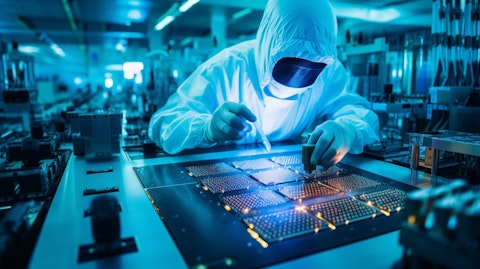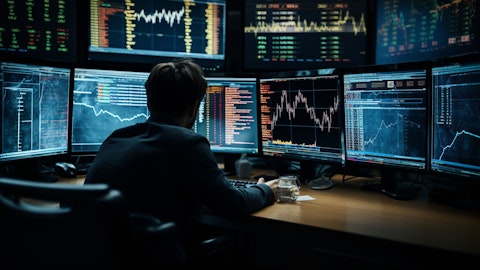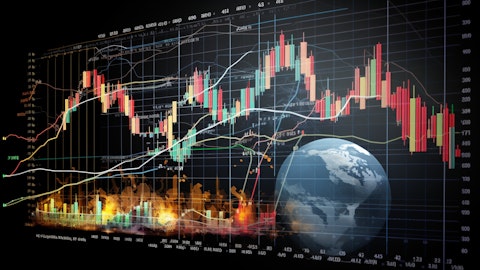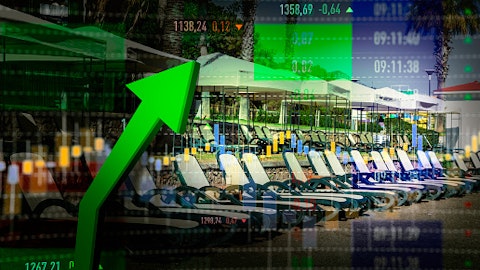ASML Holding N.V. (NASDAQ:ASML) Q2 2024 Earnings Call Transcript January 24, 2024
ASML Holding N.V. isn’t one of the 30 most popular stocks among hedge funds at the end of the third quarter (see the details here).
Operator: Good day and thank you for standing by. Welcome to the ASML 2023 Fourth Quarter and Full Year Financial Results Conference Call on January 24, 2024. [Operator Instructions] Please be advised that today’s conference is being recorded. I would now like to hand the conference over to Mr. Skip Miller. Please go ahead.
Skip Miller: Thank you, operator. Welcome, everyone. This is Skip Miller, Vice President of Investor Relations at ASML. Today on the call are ASML’s CEO, Peter Wennink; and our CFO, Roger Dassen. The subject of today’s call is ASML’s 2023 fourth quarter and full year results. The length of this call will be 60 minutes and questions will take in the order that they are received. This call is also being broadcast live over the Internet at asml.com. A transcript of management’s opening remarks and a replay of the call will be available on our website shortly following the conclusion of this call. Before we begin, I’d like to caution listeners that comments made by management during this conference call will include forward-looking statements within the meaning of the Federal Securities Laws.
These forward-looking statements involve material risks and uncertainties. For a discussion of risk factors, I encourage you to review the Safe Harbor statement contained in today’s press release and the presentation found on our website at asml.com and in ASML’s annual report on Form 20-F and other documents as filed with the Securities and Exchange Commission. With that, I’d like to turn the call over to Peter Wennink for a brief introduction.
Peter Wennink: Thank you, Skip. Welcome, everyone and thank you for joining us for our fourth quarter and full year 2023 results conference call. Before we begin the Q&A session, Roger and I would like to provide you an overview and some commentary on the fourth quarter and the full year 2023, as well as provide our view of the coming quarters. And Roger will start with a review of our fourth quarter and full year 2023 financial performance, with some added comments on our short-term outlook and I will complete the introduction with some additional comments on the current business environment and on our future business outlook. Roger?
Roger Dassen: Thank you, Peter and welcome, everyone. I will first review the fourth quarter and full year 2023 financial accomplishments and then provide guidance on the first quarter of 2024. Let me start with our fourth quarter accomplishments. Net sales came in at €7.2 billion which is just above our guidance, primarily due to more installed base business. We shipped 10 EUV systems and recognized €2.3 billion revenue from 13 systems this quarter. Net system sales of €5.7 billion which was mainly driven by Logic at 63% and with the remaining 37% coming from Memory. Installed Base Management sales for the quarter came in at €1.6 billion which was higher than guided due to additional service and upgrade sales. Gross margin for the quarter came in at 51.4% which is above our guidance, primarily driven by installed base business.
On operating expenses, R&D expenses came in at €1.041 billion and SG&A expenses given at €284 million, both basically as guided. Net income in Q4 was €2 billion, representing 28.3% of net sales and resulting in an EPS of €5.21. Turning to the balance sheet; we ended the fourth quarter with cash, cash equivalents and short-term investments at a level of €7 billion. Moving to the order book; Q4 net system bookings came in at €9.2 billion which is made up of €5.6 billion for EUV bookings and €3.6 billion for non-EUV bookings. These values also include inflation corrections. Net system bookings in the quarter are more balanced between Logic and Memory relative to past few quarters, with logic at 53% of the bookings, while memory accounted for the remaining 47%.
Looking at the full year, net sales grew 30% to €27.6 billion, with a gross margin of 51.3%. EUV system sales grew 30% to €9.1 billion, realized from 53 systems while a total, we shipped 42 EUV systems in 2023. DPV system sales grew 60% to €12.3 billion. Our metrology and inspection system sales decreased 19% to €536 million. Looking at the market segments for 2023; logic system revenue was €16 billion which is a 60% increase from last year. Memory system revenue was €6 billion which is a 9% increase from last year. Installed base management sales was €5.6 billion which is a 2% decrease compared to previous year. At the end of 2023, we finished with a backlog of €39 billion. Our R&D spending increased to €4 billion in 2023 as we continue to invest in innovation across our full product portfolio.
Overall, R&D investments as a percentage of 2023 sales were about 14%. SG&A increased to €1.1 billion in 2023 which was about 4% of sales. Net income for the full year was €7.8 billion, 28.4% of net sales, resulting in an EPS of €19.91. We finished 2023 with a free cash flow generation of €3.2 billion. We returned €3.3 billion to shareholders through a combination of dividends and share buybacks in 2023. With that, I would like to turn to our expectations for the first quarter of 2024. We expect Q1 net sales to be between €5 billion and €5.5 billion. We expect our Q1 installed base management sales to be around €1.3 billion. Gross margin for Q1 is expected to be between 48% and 49%. Lower revenue and margin relative to Q4 is primarily driven by lower emerging volume, along with an unfavorable change in product mix.
In addition, we also expect EUV volume and lower installed base business in Q1 relative to Q4. The relatively slow start to the year is a reflection of the current state of the industry coming out of a downturn. As it relates to gross margin, I would like to make a few more comments on the 2024 margin drivers as well as our longer-term ambitions of 54% to 56% by 2025. We finished 2023 with a full year gross margin of 51.3% and there are a number of developments that could impact the gross margin in 2024. For EUV, positive drivers include a higher ASP of the 3800E as well as improving EUV service margins. For DPV, we expect product mix to have a negative impact on margin in 2024. On our installed base business, we currently expect a similar gross margin as 2023 but the final impact will ultimately depend on the level of upgrades in 2024.
And finally, as we have said before, we expect significant costs in 2024 related to the introduction of High-NA and to the ramp of our capacity to 90 EUV, 600 DPV levels that we have talked about before which will create pressure on the gross margin. When we assess the combined effects of these different developments, we expect a slightly lower gross margin in 2024 compared to 2023. We are still targeting our earlier communicated gross margin ambition of 54% to 56% by 2025. This increase in gross margin will be driven by a number of items. First, higher sales volume, both in EUV and DPV which improved fixed cost coverage. Second, a move to a higher-margin EUV 0.33 NA system as the vast majority of systems in 2025 are planned to be 3,800 E-Systems.

Third, we expect reduced headwinds from capacity investments as we ramp volume, including high NA. Fourth, we will also be transitioning to a higher-margin EUV high NA system, the 5200 in 2025. Lastly, we expect our installed base business to have a positive impact on 2025 margins due to both improved EUV service margins as well as increased upgrade business volume. The expected R&D expenses for Q1 are around €1.07 billion and SG&A is expected to be around €300 million. Our estimated 2024 annualized effective tax rate is expected to be between 16% and 17%. In Q4, ASML paid the second quarterly interim dividend of €1.45 per ordinary share. ASML intends to declare a total dividend for the year 2023 of €6.10 per ordinary share. The third interim dividend of €1.45 per ordinary share will be made payable on February 14, 2024.
Recognizing this third interim dividend and the 2 interim dividends of €1.45 per ordinary share paid in 2023, this leads to a final dividend proposal to the general meeting of €1.75 per ordinary share. In Q4 2023, no shares were purchased. With that, I would like to turn the call back over to Peter.
Peter Wennink: Thank you, Roger. As Roger has highlighted, we had another year of very strong growth in a very challenging environment. And we finished the year with a solid backlog of €39 billion. The uncertainty remains in the market due to a number of global macro concerns, while the semiconductor industry is currently working through the bottom of the cycle. Our customers are still not certain on the shape or slope of the recovery this year but there are some positive signs in the indicators that we have been monitoring. Industry end market inventory levels continue to improve, moving towards more healthy levels. Lithography 2 utilization levels are still running lower than normal but are now improving in both logic and memory.
We expect utilization levels to continue to improve over the course of this year. And lastly, as mentioned by Roger, we saw very strong order intake in the fourth quarter in support of future demand. To be able to follow the curve of the industry recovery, we are looking at the combined demand for 2024 and 2025. As mentioned last quarter, we fueled 2024 as a transition year in preparation with the expected strong demand in 2025. We, therefore, continue to make investment this year, both in capacity ramp and in technology to be ready for the upturn in the cycle. While we see some positive signs of recovery, we feel it might be a bit too early to change our perhaps conservative view as communicated last quarter and therefore, still stay with our previously communicated expectation of 2024 revenue to be similar to 2023.
Looking at the market segments; customers are indicating they are seeing healthy growth this year, primarily driven by AI-related demand for both Logic and Memory but also expected from other end markets as inventory levels improve. And coming off a very strong year in 2023 with 60% growth in Logic revenue, we expect some pause in demand as customers digest the capacity additions and while utilization levels improve. Based on current demand, we see lower Logic revenue in 2024 versus 2023. For Memory, inventories are approaching normal levels and customers are expecting to see demand growth on a number of end markets this year. Litho demand is primarily driven by DRAM technology node transitions in support of advanced memories such as DDR5 and HBM in support of AI-related demand.
We currently see revenue growth in our 2024 memory business versus 2023. Turning to our businesses for EUV; we are expecting revenue growth in 2024 and we are planning to recognize revenue on a similar number of EUV low-NA systems as 2023 which includes the fast shipments for 2023. Although we planned a similar number of systems as 2023, we will have higher ASPs from the NXE:3800E systems, more weighted towards the second half of the year. In addition, we expect revenue from 1 or 2 high-NA sectors. Based on the aforementioned, we expect our non-EUV business to be down in 2024, primarily driven by lower immersion sales relative to 2023. For our installed base business, based on our view today, we expect a similar level of revenue compared to last year, plus the recovery becomes more clear this year.
Customers may likely look to upgrade their systems in preparation for 2025. And this could provide future business opportunity this year. As a reflection of the current state of the industry coming out of a downturn and an expected recovery over the course of 2024, we expect a stronger second half relative to the first half of this year. On the geopolitical front, as communicated earlier, we do not expect to get export licenses for our most advanced immersion systems, the NXE:2000 and up for China in 2024. We have been in contact with the U.S. government on their export control regulations announced in October last year and we can confirm the estimated financial impact as communicated in October. At that time, we stated the impact of the Dutch and the U.S. export control regulations combined is 10% to 15% of our 2023 China system revenue.
This impact is based on our presumption that as of 2024, we will not obtain export licenses for NXE:2000 and up immersion systems to Chinese customers. And in the case of only a handful of Chinese fabs, this also includes NXE:1970 and 1980 systems. While the export regulations had an impact on our business, we continue to see strong demand for mid-critical and mature nodes in China. Looking longer term, while there are still significant uncertainties, primarily driven by the macro environment, it appears we are passing through the bottom of this specific cycle and expect an industry recovery over the course of 2024. Based on discussions with our customers and supported by our strong backlog, we currently expect 2025 to be a strong year driven by a number of factors.
First, the secular growth drivers in the semiconductor end markets which we have previously discussed, such as energy transition electrification and AI. The expanding applications, along with increasing lithography on future technology nodes, drives demand for both advanced and mature nodes. Second, the industry expects to be in the middle of a cyclical upturn in 2025. And last, as mentioned earlier, we need to prepare for a significant number of new fabs that are being built across the globe in some instances clearly supported by several government incentive plans. These steps are spread geographically, are strategic for our customers and are scheduled to take our tools. It is essential that we keep our focus on the future and build capacity in preparation for further long-term growth as we discussed in the market scenarios for 2025 and 2030 during our Investor Day in November 2022.
We plan to update our view during our Investor Day this year on November 14, 2024. In summary, although there are still near-term uncertainties with a positive outlook trend, we clearly remain confident in our long-term growth opportunity. And with that, we’d be happy to take your questions.
Skip Miller: Thank you, Roger and Peter. The operator will instruct you momentarily on the protocol for the Q&A session. Beforehand, I’d like to ask you that you kindly limit yourself to one question with one short follow-up, if necessary. This will allow us to get to as many callers as possible. Now, operator, could we have your final instructions and then the first question, please?
See also 15 Countries That Waste the Most Water and 22 Most Famous Hedge Fund Managers and Their Top Stock Picks.
Q&A Session
Follow A S M L Holding N V (NASDAQ:ASML)
Follow A S M L Holding N V (NASDAQ:ASML)
Operator: [Operator Instructions] And the first question comes from the line of Mehdi Hosseini from Susquehanna.
Mehdi Hosseini: Two follow-ups. Peter, you’re talking about your view on ’24 is still cautious but you could always change as the year progresses. Can you share with us the puts and takes, what are the key areas that could actually give you confidence and help drive upside? And I have a follow-up.
Peter Wennink: Yes. Okay. Yes, I think in the prepared remarks, I already alluded to it, I think we will see — we are seeing the first signs, the positive signs of a recovery which is basically the data we get on inventory levels but also we see our utilization rates going up again. That — and also in the history, not only of the company but the industry means that we’re in a recovery cycle, you will see that continuing throughout the year which means that 2025 could be the first full year of the recovery. Now having said that, to assess the slope of the recovery, we take a bit of a conservative view that could, of course, change. So if the slope of the recovery is a bit faster than we think than some of that 2025 business which we’re preparing, by the way, to ship or at least to build in 2024 could actually be shipped in 2024.
Now I don’t think it’s going to be in the first half but some of that — if you talk about key areas of potentially improvement. That could be an area seeing some pull-in for system shipments into 2024, one. Two, I think when that happens, customers see it happening. But we also see that they might have some time to take advantage of the time before full utilization and do upgrades and actually installed base business which is generally high-margin business. I think those are, I think, the two main areas where we see upside — potential upside for 2024.
Mehdi Hosseini: Okay. So it’s not really driven by any particular end market or application. It could be just a broad-based recovery that could give confidence to our customer and there will be some pool-ins, right?
Peter Wennink: Yes. That’s always the case. I mean, you could argue, I mean, we have seen the focus on AI in the memory space. Now clearly, that could happen. But I think it’s generally the end markets that are reflective of where the recovery will take us in 2024. That will actually drive higher utilization of our tools and will mean pull in of those machines because customers don’t want to miss the market upturn. I think it’s all a bit of the same because the end markets ultimately will have to — will have to drive the recovery. And I think AI is now particularly something which could be on top of that because that’s clearly a technology transition. But we’ve already seen a very positive effect of that in our Q4 order intake.
Mehdi Hosseini: Okay. If I may ask my follow-up. In the last Capital Market Day, you highlighted how DRAM could account for 30% of your EUV shipment in ’25. How does that transition looks like? Maybe you can share with us the DRAM mix of EUV shipment in ’23? And how does the ’24 look like as we focus on a 30% target mix for ’25?
Peter Wennink: Well, in ’23, our memory shippers were lower than the 30% that you mentioned. But if you look at 25% and we also take into account what I just said about AI and the need for EUV in the DDR5 and in the HBM era, then the 30% is a very safe path and could be on the conservative side.
Operator: We will now go to the next question. And your next question comes from the line of Joe Quatrochi from Wells Fargo.
Joe Quatrochi: I know you reported the orders for both low NA and high NA this quarter. But can you help us just kind of quantify that mix in the orders this quarter? I imagine that the high enablers that you’re receiving now are for deliveries that are beyond 2025 at this point?
Roger Dassen: Yes, Joe, as you know, we never disclose high NA orders and we do it for a good reason. I’ve said it before. The world is very small and high NA orders are something that is competitively sensitive for our customers. So that’s why customers, they don’t want us to be specific on High-NA. I think it is fair to say that if you look at the €5.6 billion of order intake for EUV that we recorded in Q4, obviously, the lion’s share of that is none that should be very clear. In terms of overall orders that we have for High-NA, I think a couple of quarters ago, we said it’s now double digit. I think since then, we had a few quarters where we added a couple — so I think that’s what we’re looking at. But the lion’s share of the order intake in the quarter really was obviously for Low-NA.
Joe Quatrochi: Got it. That’s helpful. And then just as a follow-up, can you give us the puts and takes on free cash flow this quarter. I wonder, I guess, thought that it might have been a bit higher given the record level of EUV orders and the associated partial down payments that are related to that. So just any help you could give us on the free cash flow this quarter?





